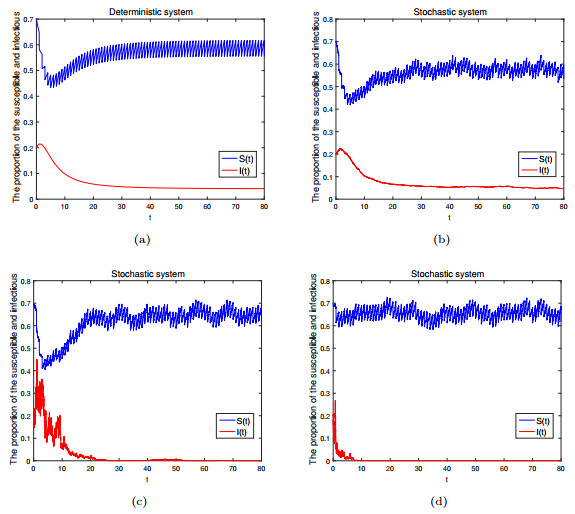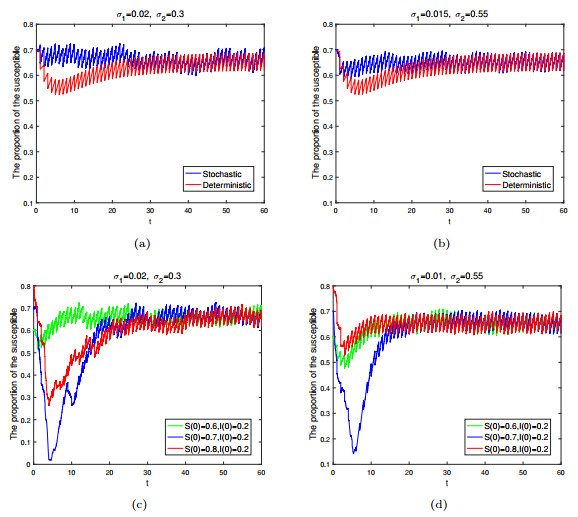|
[1]
|
Z. Agur, L. Cojocaru, G. Mazor, et al, Pulse mass measles vaccination across age cohorts, P. Natl. Acad. Sci. USA., 1993, 90(24), 11698–11702. doi: 10.1073/pnas.90.24.11698
CrossRef Google Scholar
|
|
[2]
|
A. La. Barbera and B. Spagnolo, Spatio-temporal patterns in population dynamics. Physica A, 2002, 314, 120–124. doi: 10.1016/S0378-4371(02)01173-1
CrossRef Google Scholar
|
|
[3]
|
O. Chichigina, D. Valenti and B. Spagnolo, A simple noise model with memory for biological systems, Fluct. Noise. Lett., 2005, 5(02), L243–L250. doi: 10.1142/S0219477505002616
CrossRef Google Scholar
|
|
[4]
|
Y. Cai, Y. Kang, M. Banerjee and W. Wang, A stochastic SIRS epidemic model with infectious force under intervention strategies, J. Differ. Equations., 2015, 259(12), 7463–7502. doi: 10.1016/j.jde.2015.08.024
CrossRef Google Scholar
|
|
[5]
|
O. A. Chichigina, A. A. Dubkov, D. Valenti and B. Spagnolo, Stability in a system subject to noise with regulated periodicity, Phys. Rev. E, 2011, 84(021134), 1–10.
Google Scholar
|
|
[6]
|
A. D'Onofrio, Pulse vaccination strategy in the SIR epidemic model: Global asymptotic stable eradication in presence of vaccine failures, Math. Comput. Model., 2002, 36(4–5), 473–489. doi: 10.1016/S0895-7177(02)00177-2
CrossRef Google Scholar
|
|
[7]
|
A. D'Onofrio, Stability properties of pulse vaccination strategy in SEIR epidemic model, Math. Biosci., 2002, 179(1), 57–72.
Google Scholar
|
|
[8]
|
A. A. Dubkov and B. Spagnolo, Verhulst model with Lévy white noise excitation, Eur. Phys. J. B, 2008, 65(3), 361–367. doi: 10.1140/epjb/e2008-00337-0
CrossRef Google Scholar
|
|
[9]
|
A. Fiasconaro, D. Valenti and B. Spagnolo, Noise in ecosystems: A short review, Math. Biosci. Eng., 2004, 1(1), 185–211.
Google Scholar
|
|
[10]
|
A. Fiasconaro, D. Valenti, B. Spagnolo, et al., Nonmonotonic behavior of spatiotemporal pattern formation in a noisy Lotka-Volterra system, Acta. Phys. Pol. B, 2004, 05(02), L305–L311.
Google Scholar
|
|
[11]
|
S. Gao, L. Chen, J. Nieto and A. Torres, Analysis of a delayed epidemic model with pulse vaccination and saturation incidence, Vaccine, 2006, 24(35–36), 6037–6045. doi: 10.1016/j.vaccine.2006.05.018
CrossRef Google Scholar
|
|
[12]
|
A. Gray, L. Hu, X. Mao and J. Pan, A stochastic differential equation SIS epidemic model, Siam. J. Appl. Math., 2011, 71(3), 876–902. doi: 10.1137/10081856X
CrossRef Google Scholar
|
|
[13]
|
S. Gao, D. Zhong and Z. Yan, Analysis of novel stochastic switched SILI epidemic models with continuous and impulsive control, Physica. A., 2018, 495, 162–171. doi: 10.1016/j.physa.2017.12.050
CrossRef Google Scholar
|
|
[14]
|
S. Gao, L. Chen and Z. Teng, Pulse vaccination of an SEIR epidemic model with time delay, Nonlinear. Anal-Real., 2008, 9(2), 599–607. doi: 10.1016/j.nonrwa.2006.12.004
CrossRef Google Scholar
|
|
[15]
|
D. J. Higham, An algorithmic introduction to numerical simulation of stochastic differential equations, Siam. Rev., 2001, 43(3), 525–546. doi: 10.1137/S0036144500378302
CrossRef Google Scholar
|
|
[16]
|
L. Imhof and S. Walcher, Exclusion and persistence in deterministic and stochastic chemostat models, J. Differ. Equations., 2005, 217(1), 26–53.
Google Scholar
|
|
[17]
|
Z. Jin, M. Haque and Q. Liu, Pulse vaccination in the periodic infection rate SIR epidemic model, Int. J. Biomath., 2008, 1(4), 409–432. doi: 10.1142/S1793524508000370
CrossRef Google Scholar
|
|
[18]
|
N. Joseph, S. H. Subba, M. Nelliyanil, et al, A study of the knowledge and attitude towards pulse polio immunization in semi urban areas of South India, Australas. Med. J., 2011, 4(2), 81–86.
Google Scholar
|
|
[19]
|
R. Khasminskii, Stochastic stability of differential equations, second edition, Springer-Verlag, Berlin, 2012.
Google Scholar
|
|
[20]
|
Y. Li and J. Cui, The effect of constant and pulse vaccination on SIS epidemic models incorporating media coverage, Commun. Nonlinear. Sci., 2009, 14(5), 2353–2365. doi: 10.1016/j.cnsns.2008.06.024
CrossRef Google Scholar
|
|
[21]
|
Y. Lin, D. Jiang and T. Liu, Nontrivial periodic solution of a stochastic epidemic model with seasonal variation, Appl. Math. Lett., 2015, 45, 103–107. doi: 10.1016/j.aml.2015.01.021
CrossRef Google Scholar
|
|
[22]
|
D. Li, S. Liu, J. Cui, Threshold dynamics and ergodicity of an SIRS epidemic model with Markovian switching, J. Differ. Equations., 2017, 263(12), 8873-8915. doi: 10.1016/j.jde.2017.08.066
CrossRef Google Scholar
|
|
[23]
|
Q. Liu, D. Jiang, T. Hayat and B. Ahmad, Analysis of a delayed vaccinated SIR epidemic model with temporary immunity and Lévy jumps, Nonlinear. Anal-Hybri., 2018, 27, 29–43. doi: 10.1016/j.nahs.2017.08.002
CrossRef Google Scholar
|
|
[24]
|
G. Liu, X. Wang, X. Meng and S. Gao, Extinction and persistence in mean of a novel delay impulsive stochastic infected predator-prey system with jumps, Complexity, 2017, 2017, 1–15.
Google Scholar
|
|
[25]
|
X. Lv, X. Meng and X. Wang, Extinction and stationary distribution of an impulsive stochastic chemostat model with nonlinear perturbation, Chaos. Soliton. Fract., 2018, 110, 273–279. doi: 10.1016/j.chaos.2018.03.038
CrossRef Google Scholar
|
|
[26]
|
M. Liu and K. Wang, On a stochastic logistic equation with impulsive perturbations, Comput. Math. Appl., 2012, 63(5), 871–886. doi: 10.1016/j.camwa.2011.11.003
CrossRef Google Scholar
|
|
[27]
|
Y. Lin and D. Jiang, Long-time behaviour of a perturbed SIR model by white noise, Discrete. Cont. Dyn-B., 2013, 18(7), 1873–1887.
Google Scholar
|
|
[28]
|
X. Meng, L. Chen and B. Wu, A delay SIR epidemic model with pulse vaccination and incubation times, Nonlinear. Anal-Real., 2010, 11(1), 88–98.
Google Scholar
|
|
[29]
|
X. Mao, Stochastic differential equations and applications, Horwood Publishing, Chichester, 1997.
Google Scholar
|
|
[30]
|
X. Meng and L. Chen, The dynamics of a new SIR epidemic model concerning pulse vaccination strategy, Appl. Math. Comput., 2008, 197(2), 582–597.
Google Scholar
|
|
[31]
|
X. Meng, L. Wang and T. Zhang, Global dynamics analysis of a nonlinear impulsive stochastic chemostat system in a polluted environment, J. Appl. Anal. Comput., 2016, 6(3), 865–875.
Google Scholar
|
|
[32]
|
H. Qi, X. Meng and T. Feng, Dynamics analysis of a stochastic non-autonomous one-predatoršCtwo-prey system with Beddington-DeAngelis functional response and impulsive perturbations, Adv. Differ. Equ., 2019, 2019(235), 1–35.
Google Scholar
|
|
[33]
|
L. Stone, B. Shulgin and Z. Agur, Theoretical examination of the pulse vaccination policy in the SIR epidemic model, Math. Comput. Model., 2000, 31(4–5), 207–215. doi: 10.1016/S0895-7177(00)00040-6
CrossRef Google Scholar
|
|
[34]
|
D. Valenti, A. Fiasconaro and B. Spagnolo, Pattern formation and spatial correlation induced by the noise in two competing species, Acta. Phys. Pol. B, 2004, 35(4), 1481–1489.
Google Scholar
|
|
[35]
|
D. Valenti, L. Tranchina, M. Brai, A. Caruso, C. Cosentino and B. Spagnolo, Environmental metal pollution considered as noise: Effects on the spatial distribution of benthic foraminifera in two coastal marine areas of Sicily (Southern Italy), Ecol. Model., 2008, 213(3–4), 449–462. doi: 10.1016/j.ecolmodel.2008.01.023
CrossRef Google Scholar
|
|
[36]
|
X. Wang, W. Xu and X. Liu, Stochastic stability of stochastic switched epidemic models with constant and impulsive control schemes, Chaos. Soliton. Fract., 2015, 78, 185–193. doi: 10.1016/j.chaos.2015.06.021
CrossRef Google Scholar
|
|
[37]
|
F. Wang, X. Wang, S. Zhang and C. Ding, On pulse vaccine strategy in a periodic stochastic SIR epidemic model, Chaos. Soliton. Fract., 2014, 66, 127–135. doi: 10.1016/j.chaos.2014.06.003
CrossRef Google Scholar
|
|
[38]
|
P. Xia, X. Zheng and D. Jiang, Persistence and nonpersistence of a nonautonomous stochastic mutualism system, Abstr. Appl. Anal., 2013, 2013, 1–13.
Google Scholar
|
|
[39]
|
Y. Zhao and D. Jiang, The threshold of a stochastic SIRS epidemic model with saturated incidence, Appl. Math. Lett., 2014, 34, 90–93. doi: 10.1016/j.aml.2013.11.002
CrossRef Google Scholar
|
|
[40]
|
X. Zhang, D. Jiang, T. Hayat and B. Ahmad, Dynamics of a stochastic SIS model with double epidemic diseases driven by Lévy jumps, Physica. A., 2017, 471, 767–777. doi: 10.1016/j.physa.2016.12.074
CrossRef Google Scholar
|
|
[41]
|
S. Zhang, X. Meng, T. Feng and T. Zhang, Dynamics analysis and numerical simulations of a stochastic non-autonomous predator-prey system with impulsive effects, Nonlinear. Anal-Hybri., 2017, 26, 19–37. doi: 10.1016/j.nahs.2017.04.003
CrossRef Google Scholar
|
|
[42]
|
Y. Zhao and D. Jiang, The threshold of a stochastic SIS epidemic model with vaccination, Appl. Math. Comput., 2014, 243, 718–727.
Google Scholar
|






 DownLoad:
DownLoad:

